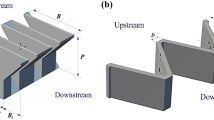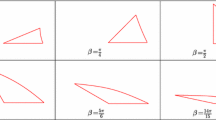Abstract
Determining the channel dimensions leading to critical flow conditions for given values of specific energy or specific force plays an important role in channel transition design. A closed-form analytical solution for the problem can only be derived for triangular, rectangular and parabolic channels. This is not possible, however, for other practical geometries, such as trapezoidal channels. The dimensions of the trapezoidal control notch are determined by simultaneously satisfying the critical state of flow and specific energy equation. At present, graphical solutions are used for design discharges less than 2.83 m3/s. In current study, direct solutions to compute the limiting dimensions of the trapezoidal channel and direct solutions to design of the trapezoidal control notch are derived. The proposed solutions are nearly exact and will be useful in the design and analysis of the trapezoidal channels and notches.
Similar content being viewed by others
References
Ankum, P. (2002). Design of open channels and hydraulics structures, Lecture Notes TU Delft University, The Netherlands.
Chaudhry, M. (2006). Open-channel flow, Springer, New York.
Chow, V. T. (1959). Open-channel hydraulics, McGraw-Hill, New York.
Das, A. (2007). “Flooding probability constrained optimal design of trapezoidal channels.” J. Irrig. Drain. Eng., ASCE, Vol. 133, No. 1, pp. 53–60.
Das, A. (2011). “Critical channel dimension for open channel transition.” J. Irrig. Drain. Eng., ASCE., Vol. 137, No. 11, pp. 735–743.
Dey, S. (1994) “No-choke flow in trapezoidal channels.” J. Eng. Mech., Vol. 120, No. 10, pp. 2224–2231.
Haltas, I. and Kavvas, M. L. (2009). “Modeling the kinematic wave parameters with regression methods.” J. Hydrol. Eng., ASCE, Vol. 14, No. 10, pp. 1049–1058.
Henderson, F. M. (1966). Open channel flow, Macmillan, New York.
Subramanya, K. (1986). Flow in open channels, Tata McGraw-Hill, New Delhi, India.
USBR (1978). Design of small canal structures, U.S. Government Printing Office, Washington, D.C., pp. 435.
Vatankhah, A. R. (2010a). “Choke-free flow in trapezoidal channels.” Proceedings of the Institution of Civil Engineers, Water Manag., ICE., Vol. 163, No. 9, pp. 439–445.
Vatankhah, A. R. (2010b). “Analytical solution of specific energy and specific force equations: Trapezoidal and triangular channels.” Adv. Water Resour., Vol. 33, No. 2, pp. 184–189.
Vatankhah, A. R. and Bijankhan, M. (2010). “Choke-free flow in circular and ovoidal channels.” Proceedings of the Institution of Civil Engineers, Water Manag., ICE., Vol. 163, No. 4, pp. 207–215.
Vatankhah, A. R. and Easa, S. M. (2011). “Explicit solutions for critical and normal depths in channels with different shapes.” Flow Meas. Instrum., Vol. 22, No. 1, pp. 43–49.
Author information
Authors and Affiliations
Corresponding author
Rights and permissions
About this article
Cite this article
Vatankhah, A.R. Limiting dimensions for trapezoidal channels and control notches (Design Aid). KSCE J Civ Eng 17, 850–857 (2013). https://doi.org/10.1007/s12205-013-0186-3
Received:
Accepted:
Published:
Issue Date:
DOI: https://doi.org/10.1007/s12205-013-0186-3




